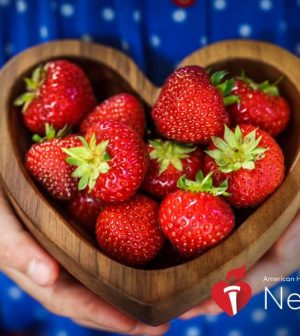- Navigating Your Midlife Crisis: Embracing New Possibilities
- City Raccoons Showing Signs of Domestication
- Mapping the Exposome: Science Broadens Focus to Environmental Disease Triggers
- One Week Less on Social Media Linked to Better Mental Health
- Your Brain Changes in Stages as You Age, Study Finds
- Some Suicide Victims Show No Typical Warning Signs, Study Finds
- ByHeart Formula Faces Lawsuits After Babies Sickened With Botulism
- Switch to Vegan Diet Could Cut Your Greenhouse Gas Emissions in Half
- Regular Bedtime Does Wonders for Blood Pressure
- Dining Alone Could Mean Worse Nutrition for Seniors
AHA News: Sweet Strawberries Are So Tempting at Valentine’s and Any Day – Should You Give In?

FRIDAY, Feb. 11, 2022 (American Heart Association News) — Whether it’s their heart shape, their seductive coloring or just the fact they make such sweet company, strawberries often are associated with romance.
And if strawberries be the food of love – eat on, experts say.
Strawberries not only taste good, they come with benefits that make them easy to embrace, nutritionally speaking.
Arpita Basu, an associate professor of nutrition at the University of Nevada, Las Vegas, has led several studies on strawberries and finds them “pretty unique from a public health nutrition perspective.”
For starters, she praises them for being low in calories and high in nutrients. Precise amounts, Basu said, vary by the fruit’s variety and ripeness. But according to the U.S. Department of Agriculture, one cup of whole strawberries has only 46 calories. With that comes almost 85 milligrams of vitamin C. That’s more than a day’s supply for an adult woman, and about 94% of what’s recommended for an adult man.
Strawberries also are low in sodium and are a good source of several other vitamins and minerals, including potassium, which is important for healthy heart, nerve and kidney function, as well as muscle contraction. A cup provides 220 mg, about 8% of a woman’s daily needs, or 6% of a man’s.
Basu also celebrates strawberries for having high levels of phytochemicals – plant-based compounds that are believed to provide multiple health benefits.
Several studies have gone straight to the heart in support of strawberries:
- A 2007 study in the Journal of the American College of Nutrition, using data collected over 16 years from more than 34,000 overweight, postmenopausal women in the Iowa Women’s Health Study, linked eating strawberries to lower risk of dying from heart disease.
- A 2020 analysis of several strawberry studies published in the British Journal of Nutrition said strawberries “significantly reduced” levels of C-reactive protein, a marker for inflammation that can be used to assess heart disease risk.
- In 2021, a small, carefully controlled study in the Journal of Nutrition suggested strawberry consumption helped blood vessels work better in people with moderately high cholesterol.
- Also in 2021, another small, carefully controlled study led by Basu and published in the journal Nutrients found that obese adults with high cholesterol who ate two and a half servings of strawberries a day saw improvements in insulin resistance.
All that, and tasty too. Which is probably why strawberries now are grown in every state and around the world. In the U.S., per-capita consumption grew from 2 pounds per person in 1980 to 8 pounds in 2013, according to the USDA.
But humans have not had such enthusiastic strawberry feels forever, possibly because the fruit we know is a relatively recent development.
Small, wild strawberries have always been around. But ancient Greek and Roman writers barely even mention them. The ancestor of the heftier berry we eat today wasn’t created until the 1700s, when French farmers accidentally cross-bred varieties imported from Chile and Virginia.
A strawberry-love connection predates that. In a Cherokee creation story, a fight between the first man and woman is resolved by a heavenly gift of strawberries. In European art, strawberries have been associated with both holiness and seduction.
If you’re feeling tempted to indulge in strawberries – go right ahead, Basu said.
Basu, whose research has received support from the California Strawberry Commission, said you can choose fresh or frozen. “Frozen strawberries give you nutritional value that’s very similar to the fresh fruit.”
If you go for fresh, examine the containers carefully; strawberries can spoil quickly. Experts say you should look for red fruits with bright green caps. Don’t cut or rinse them until you’re ready to serve.
Conventionally grown strawberries can have high levels of pesticide residue, but Basu said, “I don’t see that as a huge concern, because I don’t think they are so absolutely loaded with pesticides that they cannot be washed off, or that’s going to make somebody sick.” She eats both organic and non-organic versions.
Strawberries made into jelly or jam lose a lot of nutrition and gain a lot of sugar in processing, Basu said. But for a healthy dessert, she enjoys strawberries with a little whipped cream.
And if you’re thinking about chocolate-dipped strawberries for your love (or yourself), that can be OK, she said. Chocolate adds sugar, but if you choose dark chocolate, “you’re going to get lots of cocoa,” which is high in healthy flavonoids.
Strawberries’ taste and convenience can make them an easy way to fit more fruits and vegetables into the day. “Changing behavior is always difficult,” she said. “But it’s relatively easier to add something that people may like to eat, rather than changing the whole diet.”
American Heart Association News covers heart and brain health. Not all views expressed in this story reflect the official position of the American Heart Association. Copyright is owned or held by the American Heart Association, Inc., and all rights are reserved. If you have questions or comments about this story, please email editor@heart.org.
By Michael Merschel
Copyright © 2025 HealthDay. All rights reserved.










